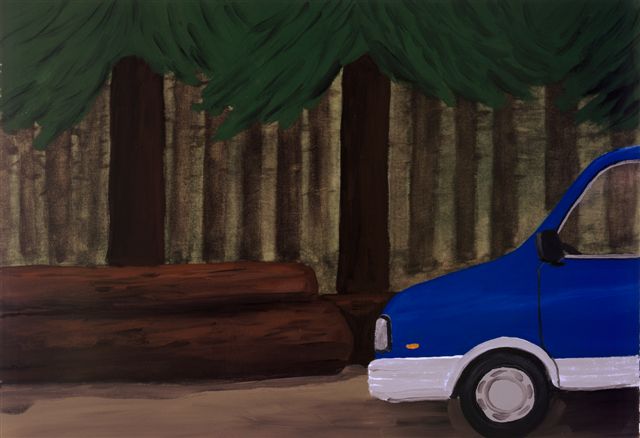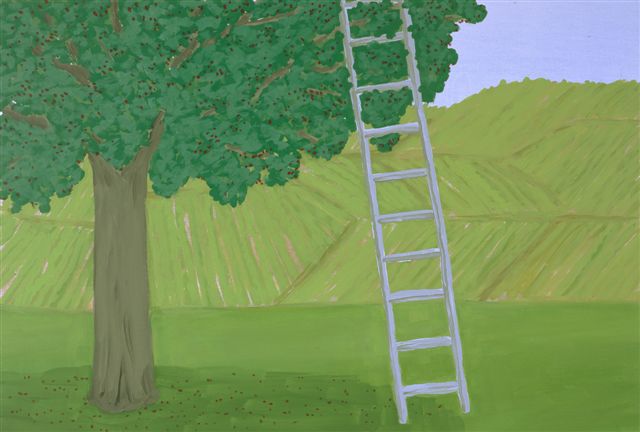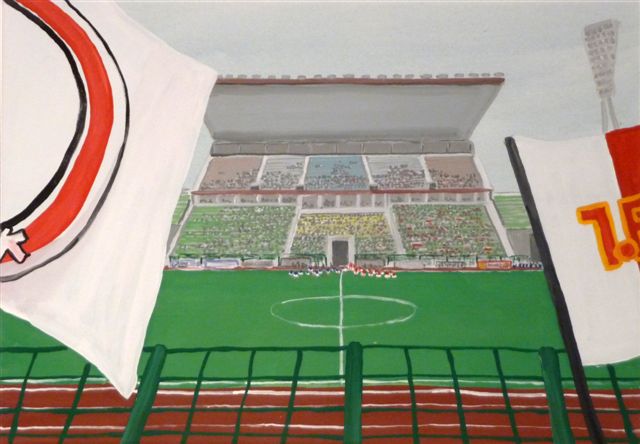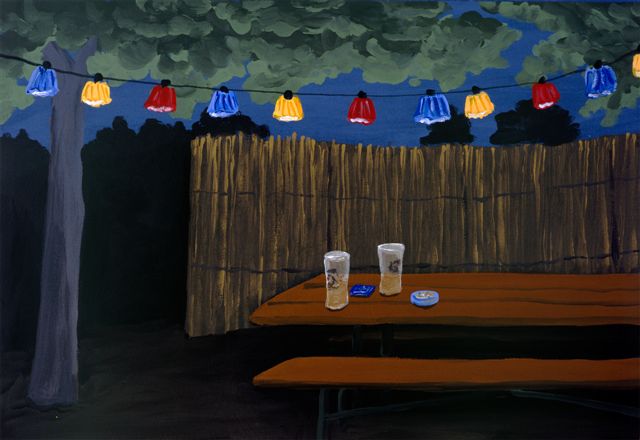… among its different shades of meaning the word ‘heimlich’ exhibits one which is identical with its opposite, ‘unheimlich’. What is heimlich thus comes to be unheimlich. […] In general we are reminded that the word ‘heimlich’ is not unambiguous, but belongs to two sets of ideas, which, without being contradictory, are yet very different: on the one hand it means what is familiar and agreeable, and on the other, what is concealed and kept out of sight.
– Sigmund Freud, The Uncanny, 1919
On a green meadow, cluttered with little many-coloured flowers, stands an empty bench. Overviewing the woods, the simple brown settle is placed on a clearing on a hill. The pleasant scenery is well ordered and approachable, as clearing and wood are separated by a primitive fence and the bench, two wooden blocks and a plank, is in line with the edges of the painting, just like the fence. Depth in perspective is indicated by two different shades of green in the nearer and further away part of the wood. Andrew Vickery’s Black Forest seat, depicting a nice summer’s day, is a modest painting, such as the other 18 small-sized gouache on canvas works, which are exhibited at the Peppercanister Gallery, Dublin. And this could be the end of the review, were that not only the tip of the iceberg. Don’t be misled by the modesty of Opera, Rosebuds or Besenkammer, as they only form the welcoming entrance door into Vickery’s complex and sophisticated visual world. Let us enter and have a closer look at some of the theoretical interior.

Vickery’s style could rightly be described as naive or childlike because it bares no aspiration to be realistic. The artist offers us only very basic discernible information on the blue car in Black Forest. The car’s overall form is universalized, just as the appearance of the details. The indicator, for instance, is simply represented by an orange colour-field. Furthermore, Vickery’s technique hardly suggests three-dimensionality. The car is shown in full profile without any angles and its body is painted in homogenous colours. It looks as if Vickery intended to display the one-dimensional cardboard standup of a car rather than a real car. Just as schematized as the car are the firs’ branches, implied by some rough but accurate set brushstrokes. Just like the trees, the trunks and the car in Black Forest, the ladder in Cherry tree, the bench in Black Forest seat or the swans in Swans are categorized exponents of their kind. They function as ‘symbol for’, a projection surface for everyone’s own associations.


But interestingly enough, Vickery’s paintings refer to particular personal memories, as suggested by the titles Grunewald September 9 and 21.03.2009. He says that "although giving the appearance of assumed naïveté and detachment, they attempt to represent very particular moments of engagement with the emphasis on the feeling of the experience." But we are not introduced to the moment’s protagonists or the narration of the memory. Is that an attempt to keep privacy? Why then linking the paintings so closely to his private life? One of the "numerous paradoxes" Vickery ascribes to his works, which create an appealing tension. But since they are all cleared of details from Vickery’s actual private life and moreover his subjects only carry symbolic meaning, it is the feeling which translates through the paintings that becomes even clearer and stronger.
Oliver’s suggests an intimate situation, depicting two chairs facing each other on a terrace in moonlight. The scenery drafts a story of conversation and romance. It arouses a comfortable feeling, but we have to tell the story ourselves. Vickery only provides us with a stage setting made out of his own memory. In fact, his paintings, supported by their small format, remind of stage settings made for old-fashioned paper toy theatres. The composition of Black Forest, for instance, is in layman’s terms, structured, and consists of four one-dimensional depth levels: car, trunks, firs and the deep woods. In between these layers, we could let our own paper actors play our personal drama. If we need an outdoor setting to come alive we can project on Sleep and death, and when an indoor scene is required, why not use Tramps to think about our last joyful night out? In the end the images double the effect of memory and association as they incorporate both the artist’s and the audience’s imagination.

Vickery’ s work is not meant for passive consumption. The highly suggestive symbols and stage scenes contain a void that desires to be filled and that makes them so incredibly intriguing. Something is missing. For example, they completely lack the presence of human beings that they nevertheless so intensly suggest. We are confronted with objects which are meant to be used and which we are familiar with from everyday life, such as the bicycles in Rosebuds and Grunewald September 09.2008, the car in Black Forest or the bench in Black Forest seat. The viewer has no choice but to animate these devices, imagine the people who were riding these bikes and driving the car, just as the persons sitting on the bench. Half-filled beer glasses in Biergarten have been served for someone, someone must have put the ladder on the Cherry tree, and someone must have left the traces in Grunewald. The paintings also solicit narration as our fantasy does not stop at populating the sceneries. What were the people who sat on the chairs in Besenkammer talking about? Why did they go to the depicted place and what happend there? And as we can’t find the answers in the artist’s output, we are thrown back to searching for them in our own fantasy.
The artistic approach recalls Umberto Eco’s theory of the ‘open work’. [1] The Italian philosopher states that the contemporary artist allows openness for the viewer’s individual interpretation, which is based on individual wealth of experience, purposely as part of his productive programme. Within this approach, the viewer has a new part to play, not only because the artwork is coming to life from a new perspective with every new interpretation, but also because the border between interpreter and recipient dissolves, for the open artwork is made to manifest itself only in its mediation. The viewer has to finish it in an act of conscious freedom – a concept that does not seem to have lost its immediacy and which is reflected in New scenes. Thus, feel free to make the paintings move and breathe!
And yet, the void in Vickery’s painting can not exclusively be interpreted as positive. The absence of people, narration and the stiff motifs evoke a disquieting feeling. We find ourselves in a kafkaesque situation – everyone seems to have left Vickery’s imaginative world, and we are the foresaken. Something is wrong in these paintings, something is not in the way it should be. The vehicles, for example, associated with movement, are either depicted in standstill, like the lorries in Grunewald, significantly depicting a traffic jam, or they seem to be frozen, like the car in The Oldest taxi. Although the composition of this painting suggests movement via an extreme vanishing-point perspective, somehow it does not convince. These elements are disturbing and uncanny – and indeed much in Vickery’s paintings fits in with Freud’s notion of the uncanny, in particular unresolved, indeterminate or unexplained nature of what is portrayed, and the way in which objects may be obscured or half-hidden. Vickery explains that his paintings are "both oblique and yet explicit" and undoubtly the settings in the exhibition are familiar and yet, somehow, they are not familiar at all.
In the end, the quiet discomfort which is evoked by New scenes does not reach the state of fear or horror. To the contrary, the 18 paintings delight with their charming simplicity and the moderate pleasant feelings they provoke, without being boring for a minute. With a twinckling eye, Vickery’s intellectual approach to painting is hidden behind a facade made out of modesty. I hope that no one fell for the trick.
Katharina Guenther is a German art historian.
1 Umberto Eco, Opera aperta (1962, rev 1976); English translation: The Open work (1989)
